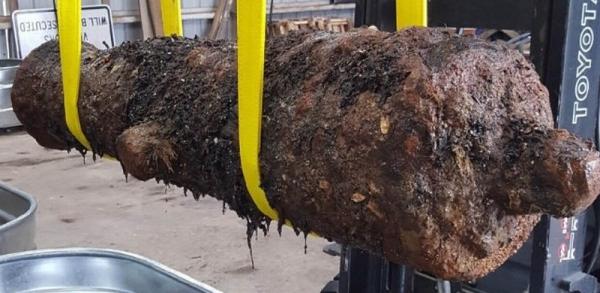 While preparing to dredge the shipping channel in the Savannah River, the U.S. Army Corps of Engineers may have found artifacts from HMS Rose, a 20-gun Royal Navy frigate, dating from the American Revolutionary War. Archaeologists with the Corps of Engineers discovered an anchor, a section of timber, and three cannons believed to date from the 1700s.
While preparing to dredge the shipping channel in the Savannah River, the U.S. Army Corps of Engineers may have found artifacts from HMS Rose, a 20-gun Royal Navy frigate, dating from the American Revolutionary War. Archaeologists with the Corps of Engineers discovered an anchor, a section of timber, and three cannons believed to date from the 1700s.
The Rose was scuttled in the river in September 1779, blocking the channel, to prevent the French fleet from aiding American soldiers attempting to capture the city of Savannah. The British held the city until July 11, 1782, when they withdrew on their own accord. After the end of the war, the wreck of the Rose was removed to reopen the channel to navigation.
As a single sixth-rate ship, HMS Rose played an outsized role in the years before and during the American Revolution. In 1767, her activities in suppressing smuggling in the colony of Rhode Island led to the formation of what became the Continental Navy. During the invasion of New York in 1776, HMS Rose and HMS Phoenix easily sailed past rebel cheval de frise and bombarded Manhattan. One Royal Navy website proudly describes HSM Rose as the “scourge of the American Revolution.”
In 1970, a replica of HMS Rose was built in Lunenburg, Nova Scotia. Initially intended as a “dockside attraction,” in 1991 the ship gained United States Coast Guard certification as a sail training vessel. In 2001, she was purchased by Fox Studios to serve as HMS Surprise for the Peter Weir movie Master and Commander: The Far Side of the World, based on the books by Patrick O’Brian. Renamed Surprise, the vessel is now a part of the Maritime Museum of San Diego as a dockside attraction.

How the current R.N. sees it:
https://www.royalnavy.mod.uk/news-and-latest-activity/news/2021/march/10/20210310-hms-rose
W have so many of them, old cannons are used as bollards in the side streets around St Katharine’s Dock and the Tower Bridge in London
I’m the guy who built the copy of ROSE in 1969, so I’m glad to learn about these pieces of her being recovered. Readers may also be interested in another recent discovery from the US-French assault on Savannah in 1779: US cavalry General Casimir Pulaski was killed in action, and buried near Savannah. While his monument was taken down for repairs, his body was examined. The DNA was a match to other members of the family, but the shape and size of the pelvis shows that HE was actually a SHE in disguise. It makes you wonder how many others there may have been.